How Ebony’s ‘funkadelic’ test kitchen broke stereotypes of Black cooking
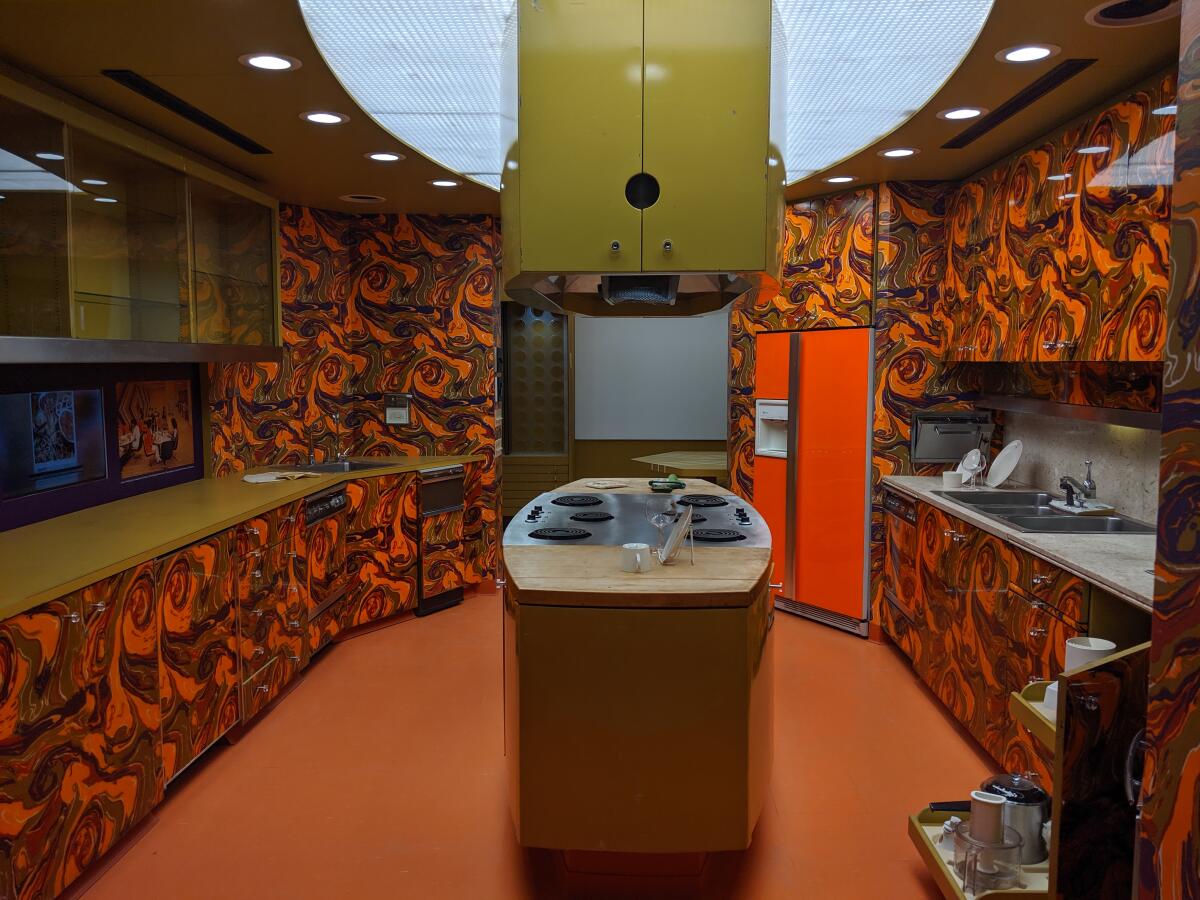
Shrinking tortillas, sriracha sauce panic and a “mid-century funkadelic” kitchen. I’m Laurie Ochoa, Food department general manager at the L.A. Times, filling in for restaurant critic Bill Addison with this week’s Tasting Notes and our latest in the ongoing gas versus electric stove debate.
Why test kitchens matter
It’s hard to overstate the thrill of walking into what is certainly the country’s most spectacularly designed test kitchen: the recently reassembled Ebony Test Kitchen on display at the Museum of Food and Drink in New York through July 17. First, consider the wallpaper — swirls of eggplant purple, avocado green and brilliant orange surrounding a harvest-gold cooking island where the magazine’s recipes for its Date With a Dish column were tested. The GE refrigerator makes a statement in bold orange. Even the built-in can opener, a Thermador “Click ‘n Clean,” has style. Chef and author Carla Hall, former co-host of “The Chew,” told the New Yorker’s Sophia Hollander that Ebony’s kitchen felt familiar to her: “That was my mother’s house. Right? That mid-century funkadelic.”
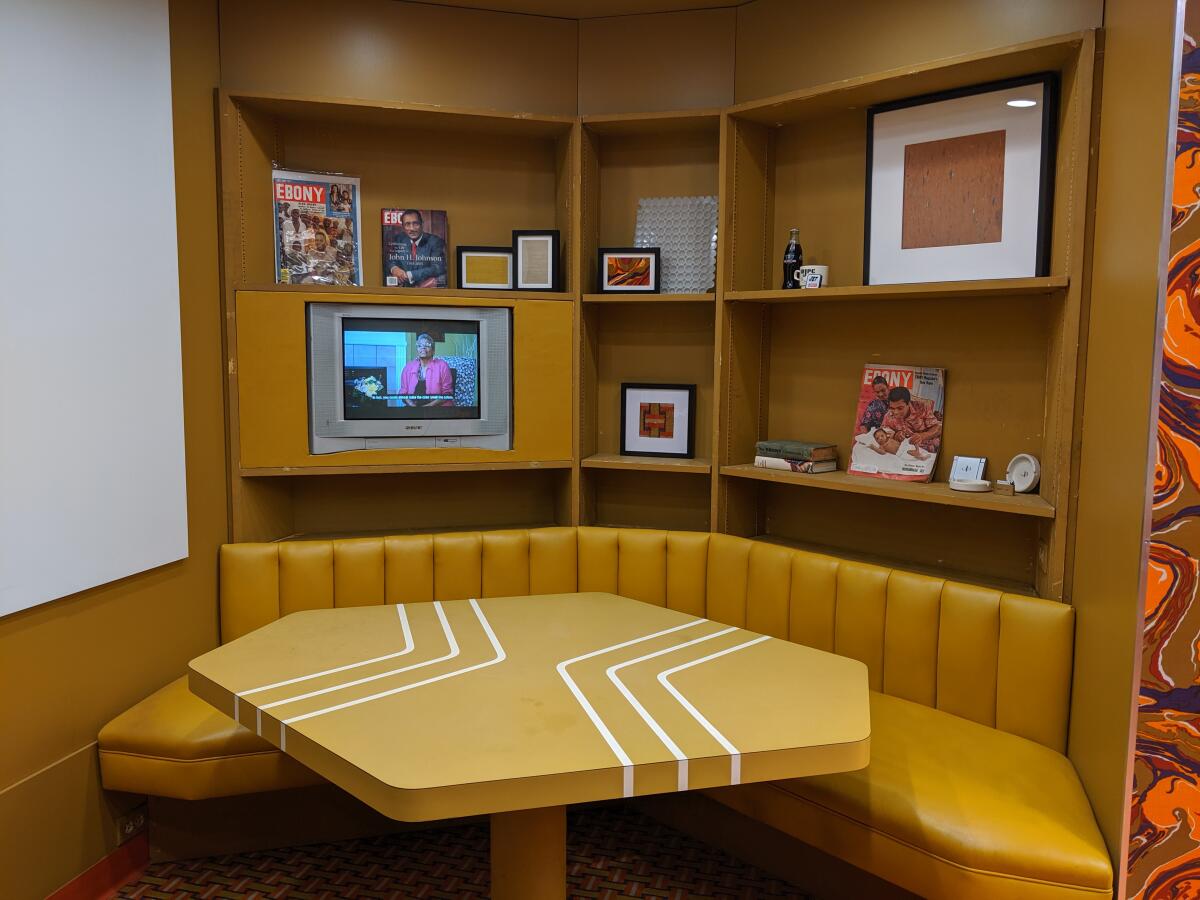
Ebony’s kitchen was part of founder John H. Johnson’s mission to show that Black life should be treated with the same respect and glamorous magazine layouts as white American life.
“In the food section, it wasn’t simply the up-from-the-South things that people think of when they stereotype African American food, but it was the world,” scholar and author Jessica Harris, lead curator of the exhibition “African/American: Making the Nation’s Table,” said in a video for the Museum of Food and Drink. “So there were dishes from the Caribbean. There were dishes that were European dishes. The food pages at Ebony quite simply celebrated what we now call the African diaspora. It expanded the kitchens of African Americans.”
I never got to see the Ebony Test Kitchen in its original Chicago home, but seeing it re-created in New York reminded me that some of the happiest times of my days in food journalism have been spent in test kitchens — first at the old L.A. Times test kitchen in downtown Los Angeles when I was food editor years ago, and then when I was executive editor at Gourmet (R.I.P.), where every cook had an apartment-style galley kitchen. Tasting recipes in development was not only a time to sample some fantastic cooking, but also a time to gather with colleagues and share ideas.
Now, after several years working with the terrific reporters, critics and editors covering entertainment and culture at the paper, I’ve returned to food. For a long time, being married to this paper’s late restaurant critic Jonathan Gold, I was able to have the best of both worlds. But next month will mark four years since Jonathan’s death, and it feels like the right time to return, especially with the paper’s commitment to invest in growing our coverage.
One big step in our plans for the future has been our return to another Times test kitchen, this one newly constructed at our El Segundo offices. Throughout the pandemic, cooking columnist Ben Mims and recipe writer Julie Giuffrida worked alone in their home kitchens; except for a rare photo shoot, there were few opportunities for the rest of the staff to gather and taste their recipes before publication. That changed on Wednesday with Ben and Julie inhabiting the kitchen and initiating what will become weekly recipe testing sessions. And on Thursday, food editor Daniel Hernandez invited a guest chef to create a Fourth of July menu in the test kitchen. Martin Draluck, profiled last year by Donovan X. Ramsey, is curator of the Black Pot Supper Club, a dinner series that adapts and brings attention to work of pioneering Black chefs, including the great Edna Lewis and enslaved chefs James Hemings and Hercules Posey. I won’t ruin the surprise and tell you what Draluck has cooked up for us, but I guarantee I’ll be making his recipes for my friends and family. Meanwhile, Draluck has a few openings left in this month’s Black Pot Supper Club dinners, which started at Hatchet Hall and now take place at Post & Beam and, for a few days this month, at a home in Whittier.
Enjoying this newsletter? Consider subscribing to the Los Angeles Times
Your support helps us deliver the news that matters most. Become a subscriber.
Still cooking with gas?
One more advantage of the brand-new Times test kitchen is its state-of-the-art equipment, which includes an electric-powered induction cooktop and gas ranges. Of course, gas ranges may not be state-of-the-art much longer. Last month, the L.A. City Council voted to ban gas stoves in new buildings. Most people agree that this will be better for the environment, but it’s not going to be an easy switch. Many chefs, as Jenn Harris reported last week, depend on gas flames to maintain the high heat needed for stir-frying in a wok. What about home cooks? Ben Mims conducted a gas versus electric test inside The Times’ kitchen. He boiled water, caramelized sugar and made fried rice on a gas burner and the induction cooktop. The results show that for many, the change may not be as difficult as we fear.
P.S.: The Ebony Test Kitchen was fully electric.
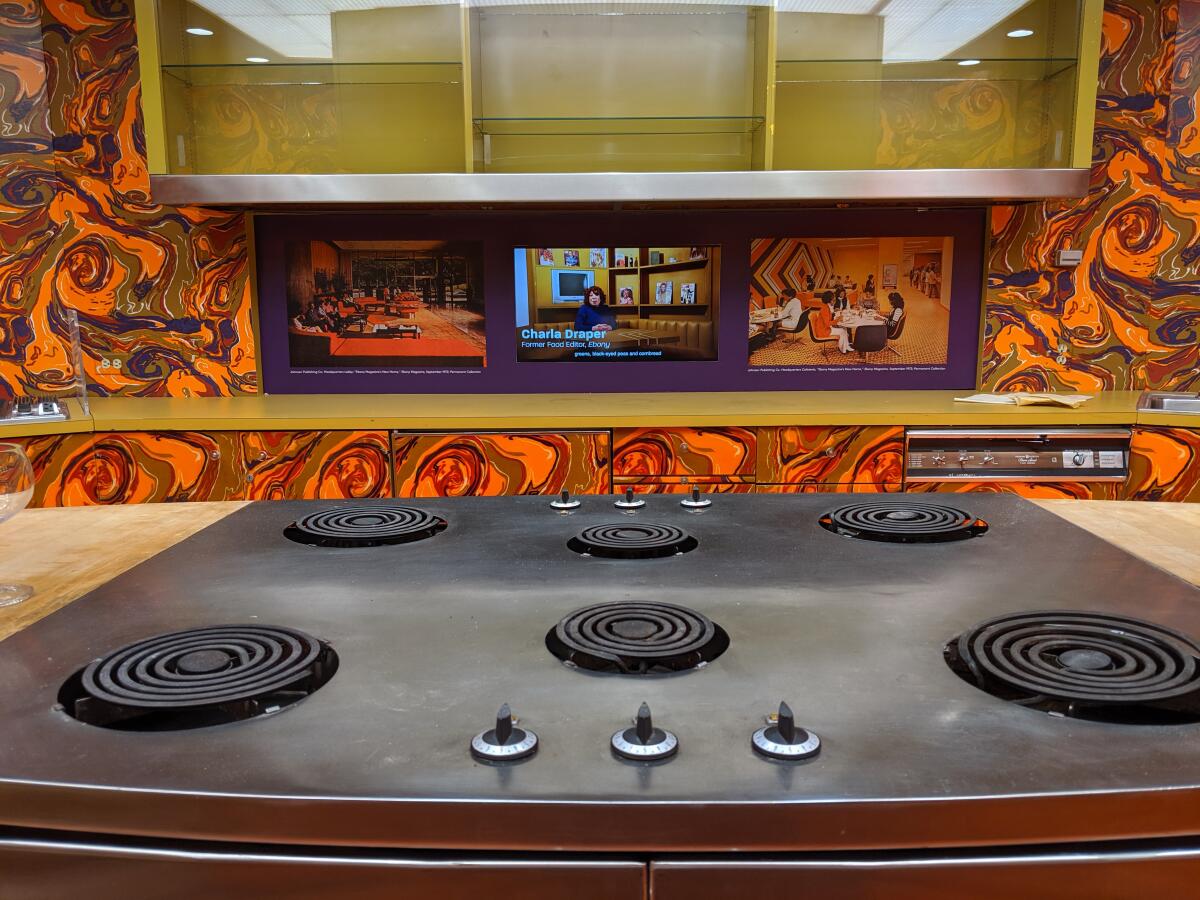
Eat your way across L.A.
Get our weekly Tasting Notes newsletter for reviews, news and more.
You may occasionally receive promotional content from the Los Angeles Times.
Vegas: An Asian food paradise
Las Vegas long ago shed its cheap buffet reputation, thanks to pioneers like French chef Jean-Louis Palladin, who in 1997 opened Napa at the Rio. Then came Lotus of Siam, which Gourmet magazine declared the best Thai restaurant in North America. This week, Times restaurant critic Bill Addison argues that the food you should seek out in Las Vegas is Asian. Inspired by the fantastic Cantonese specialties he ate at Rainbow Kitchen, he sought out more Chinese cooking and found himself exploring Asian restaurants of all sorts throughout Vegas’ Chinatown. He says it’s one of the country’s most exciting food scenes.
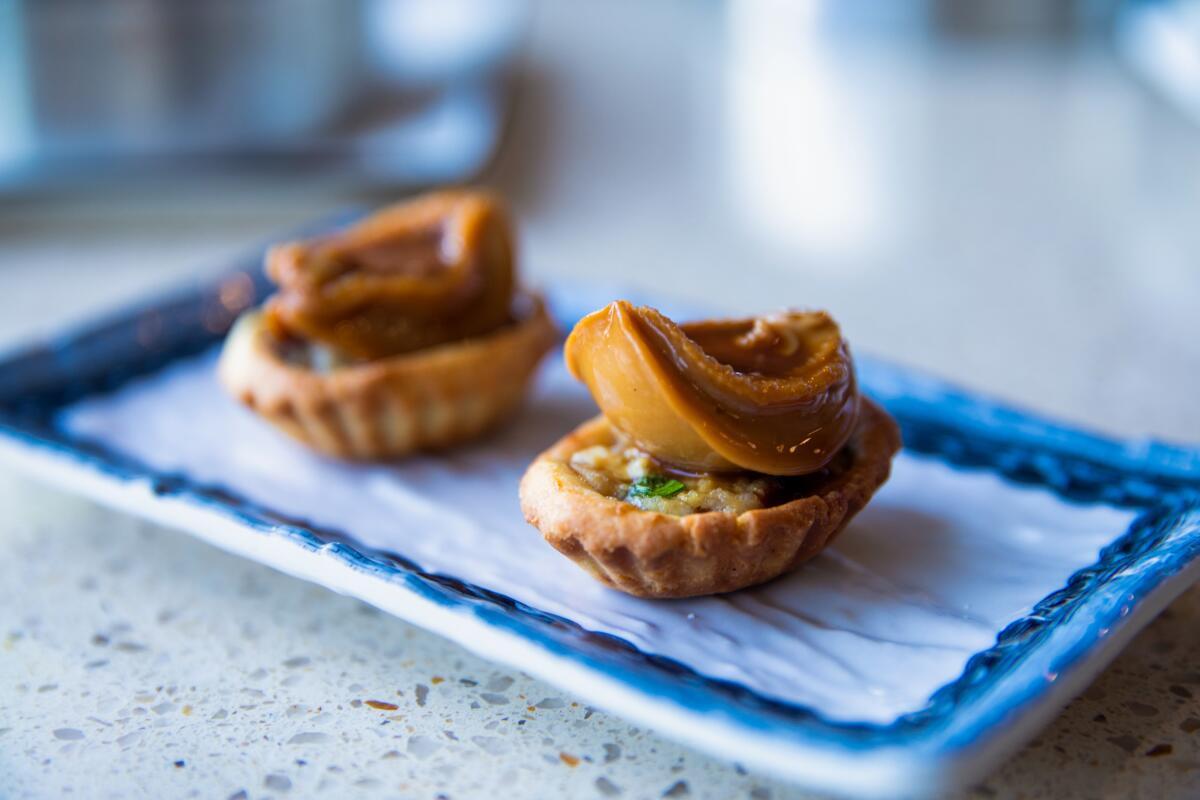
Have a question?
A summer without sriracha?
Restaurateurs and home cooks are trying not to panic over the Huy Fong Foods announcement that its famed rooster-embossed bottles of sriracha sauce are going to be in short supply this summer. “We don’t want it to become a toilet paper effect,” Pho Saigon Pearl manager and co-owner Phuong Hoang told Jenn Harris. The culprit behind the shortage? Huy Fong’s executive operations officer, Donna Lam, blames weather conditions in one region of Mexico where the chiles are grown. But she wouldn’t specify the region. Less reported in the shortage news is that Huy Fong’s other chile condiment, the garlicky sambal oelek, is also being affected. As much as I love sriracha, I love sambal oelek even more as a cooking ingredient to add heat and complexity to all kinds of dishes.
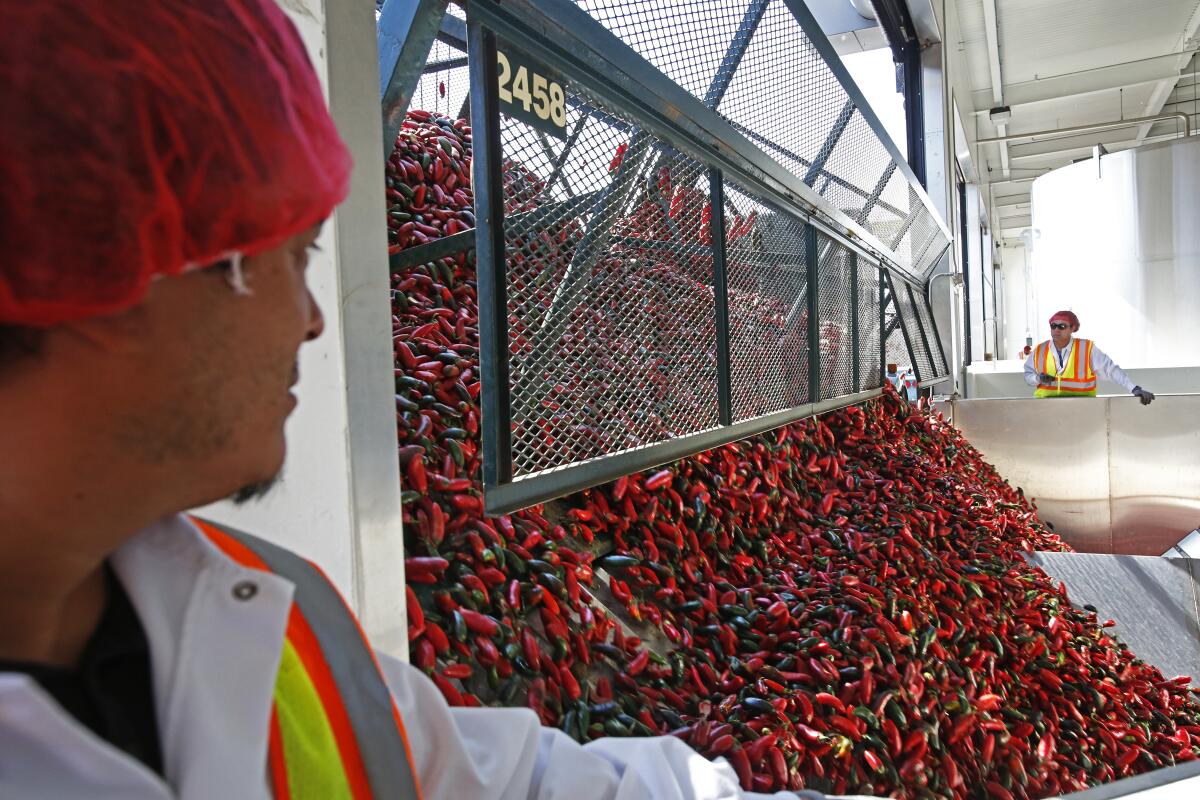
The California effect
A restaurant called Rosemead ... in Singapore. San Joaquin Valley pistachios ... in London. In our Global California series, Times correspondents explore the many California influences that have spread throughout the world. This week, Jaweed Kaleem in London and David Pierson in Singapore report on the California ingredients and restaurants that are popping up around the globe, including Nancy Silverton’s Mozza in London and Osteria Mozza in Singapore, with Grand Central Market favorite Eggslut in both cities as well, plus Kris Yenbamroong’s Night + Market in London. You’ll also find L.A. Venice restaurants Gjusta and Gjelina in Paris’ 10th arrondissement.
“Californian food is an ethos,” chef-owner Victor Garvey of London’s SOLA told Jaweed. “A brightness, lightness and freshness. ... We want to bring that to Europe.”
More stories
— “I think there should be a seat for people like me, an immigrant,” Ana Diaz, a Los Angeles Convention Center bartender who came to California from El Salvador, told Times reporter Cindy Carcamo about this week’s Summit of the Americas. Carcamo talked with several convention center workers who would be on duty during the summit, where policies that could affect their lives would be discussed. Diaz felt that she could contribute to the summit if asked: “You need to talk with the ordinary people in these countries and ask what they really need.”
— If you’re looking for recipes to celebrate Juneteenth, Ben Mims suggests Nicole A. Taylor’s “Watermelon and Red Birds: A Cookbook for Juneteenth and Black Celebrations.”
— “Expensive for a whole lot of BS,” as bar manager Eugene Lee at Big Bar & Alcove in Los Feliz told Times reporters Stephanie Breijo and Suhauna Hussain? Or a relatively painless way to prevent bar and restaurant customers from heading home too drunk to drive? California’s Responsible Beverage Service Training Act, AB 1221, goes into effect July 1 and requires that all bartenders, waitstaff and managers at “establishments licensed to serve alcohol” take a training course and certification test on “the consequences of over-serving” and “intervention techniques for dealing with inebriated customers.” “So far,” write Breijo and Hussain, out of the hundreds of thousands of workers in the state covered by the law, “just 33,000 people have become certified.”
— Stephanie Breijo also reports on the week’s restaurant news with a new Mid-City Sonoratown, a downtown L.A. outpost of Mastro’s Ocean Club, the annual pie bake sale and fundraiser Pies for Justice on June 18 and more.
— And finally, while much of the country has been riveted by Congress’ Jan. 6 hearings airing in prime time, Rep. Andy Biggs (R-Ariz.) says they are distracting us from the more important issue of tortilla shrinkage. “They don’t want you talking about, hey, the size of that pack of tortillas that I just bought last week,” he said on the floor of Congress. “They used to look like the regular-sized tortillas, now they look like mini tortillas.” No word on whether the very real issue of shrinkflation affected Biggs’ grocery haul or if he accidentally bought soft taco or street taco tortillas — sometimes called mini tortillas.
Eat your way across L.A.
Get our weekly Tasting Notes newsletter for reviews, news and more.
You may occasionally receive promotional content from the Los Angeles Times.




